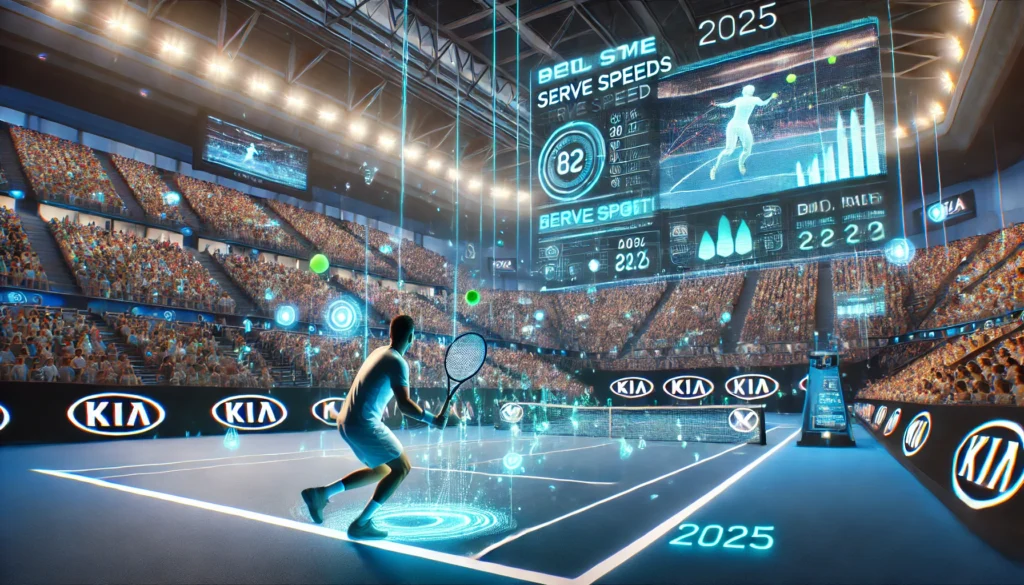by Jed Langer
The Australian Open has always been a pioneer in blending tradition with innovation. From its iconic sun-soaked courts to its reputation as the “Happy Slam,” it has consistently pushed the boundaries of what a tennis tournament can achieve. In 2025, the tournament continues this tradition—not just through its electrifying matches but by integrating cutting-edge artificial intelligence (AI) into nearly every aspect of the event.
With Infosys as its digital innovation partner, the Australian Open is leveraging generative AI to transform how the game is played, coached, and experienced. From real-time coaching tools to personalized fan highlights and AI-powered officiating, tennis isn’t just evolving—it’s getting smarter, faster, and more engaging.
Generative AI Turns Data Into Stories
For years, tennis stats—like first-serve percentages or unforced errors—have been the go-to metrics for understanding a match. But these raw numbers don’t always tell the whole story. That’s where generative AI steps in.
At the Australian Open 2025, Infosys’ AI tools analyze vast datasets in real time, identifying trends like shot patterns, momentum swings, and pivotal turning points. The best part? This data is presented as visualizations and narratives that fans can easily understand.
One standout feature is the Infosys Play of the Game, which captures and highlights the most significant moments from every match. This isn’t just a random clip—it’s a curated blend of metrics and context. The AI considers factors like rally length, player positioning, the stakes of the point (breakpoint, set point, etc.), and even crowd reactions to determine which play deserves the spotlight. For example, a 27-shot rally in a fifth-set tiebreak where both players showcase incredible athleticism isn’t just exciting—it becomes an unforgettable “Play of the Game” moment, delivered with the context that makes it even more impactful.
Imagine watching Carlos Alcaraz square off against Daniil Medvedev and receiving insights like: “Alcaraz has won 75% of points when hitting his crosscourt forehand.” Or, “Medvedev’s deep returns are keeping Alcaraz pinned behind the baseline.” This isn’t just stats—it’s storytelling that deepens your understanding of the game, whether you’re a seasoned tennis buff or a casual fan.
Hawkeye Live: Officiating Perfected
AI’s role in tennis isn’t just limited to stats and strategy. On the court, Hawkeye Live has revolutionized officiating. Using high-speed cameras and advanced algorithms, this system determines whether a ball is in or out to within a millimeter.
First trialed at the 2020 US Open, Hawkeye Live has now become the standard for tournaments like the Australian Open. It eliminates human error and ensures matches flow seamlessly without interruptions for player challenges or contentious umpire calls.
If you’ve followed tennis for a while, you’ll remember the drama that came with relying on human line umpires. Missed calls, especially on high-speed serves or tough baseline shots, could ignite controversy and even shift the momentum of matches. Some of these moments have become part of tennis lore, like when players would erupt at umpires after a blown call on a critical point. Even with the introduction of challenges, the system wasn’t perfect—it could be slow and often broke the rhythm of the match.
Hawkeye Live has removed the guesswork. By offering instant, accurate decisions, it ensures fairness and keeps the focus on the players and the game itself. Matches are faster and smoother, and players no longer waste energy on disputes. For fans, it’s a win-win: no more awkward arguments and a game that’s played on skill, not flawed officiating.
Custom Highlights: Personalizing the Fan Experience
One of the most exciting applications of generative AI at AO 2025 is its ability to enhance the fan experience. Infosys has introduced tools that let fans create custom highlight reels in seconds.
Here’s where it gets really cool: fans don’t have to sift through hours of footage to find their favorite moments. Instead, they can simply type or speak a query—like “Show me Novak Djokovic’s top drop shots from Round 1” or “Alex Michelson’s best points from set two against Stefanos Tsitsipas”—and the AI will pull together the perfect reel. The system draws on a vast data bank of match highlights, using metadata like shot type, rally length, and match context to deliver exactly what you’re looking for.
Love Iga Świątek’s backhand? You can get a compilation of her most spectacular winners. Want to relive the best tiebreak points from the men’s singles final? Done. This level of personalization ensures that fans stay engaged with the sport in a way that feels uniquely tailored to their preferences. It’s a game-changer for how audiences interact with tennis, bringing a deeper connection to the moments they care about most.
Coaching Insights: A Competitive Edge
Generative AI is also transforming how players and their coaching teams approach the game. Infosys’ tools provide deep, data-driven insights that would have been impossible to generate manually. AI analyzes opponents’ shot patterns, strengths, and weaknesses, giving players a detailed roadmap of how to prepare.
Take Alexander Zverev, for instance, who has openly spoken about how data has revolutionized tennis. “Coaches now have so much statistical information at their disposal,” Zverev said in a recent interview. “We can adapt to an opponent’s game plan like never before. Whether it’s figuring out their tendencies under pressure or identifying patterns in their second serve, we’ve got the tools to be two steps ahead.”
For example, AI might highlight how often an opponent uses a slice backhand in defensive situations or their preferred serve location when facing breakpoints. This allows players to craft hyper-specific strategies tailored to each match. In a sport where the margins between victory and defeat are razor-thin, these insights provide a crucial edge.
Even during matches, coaches can use AI-generated analyses to refine strategies on the fly. While tennis remains a physical and mental battle on the court, the brainpower behind the scenes is becoming just as important.

The Bigger Picture: AI’s Impact on Tennis
While the Australian Open is leading the charge, the broader implications of AI in tennis are vast and intriguing. From officiating to fan engagement, AI is transforming every layer of the game.
But as the technology advances, it also raises questions. Will AI analytics become so sophisticated that players can predict each other’s moves, fundamentally altering the dynamics of competition? Could the reliance on data eventually overshadow the unpredictability and artistry that make tennis so captivating?
What’s clear is that AI is no longer a supporting character in the story of tennis—it’s becoming one of its main protagonists. Balancing the benefits of AI with the sport’s human essence will be an ongoing challenge, but for now, the possibilities are endless.
Conclusion: A Smarter, More Connected Future
The Australian Open 2025 is a glimpse into what’s possible when sports and technology converge. From AI-powered insights and flawless officiating to personalized fan experiences, the tournament is setting the standard for the future of tennis.
As we look ahead, it’s exciting to imagine how AI will continue to shape the sport while preserving its essence—the moments of human brilliance, the unpredictability, and the joy of competition. At the Australian Open, one thing is certain: the game has never been smarter, more connected, or more exciting.
